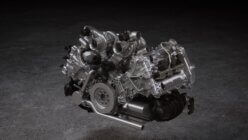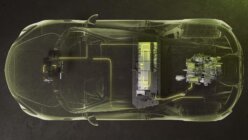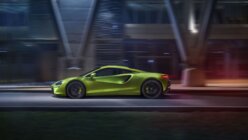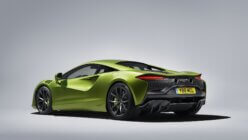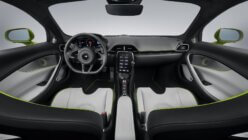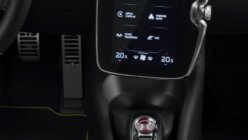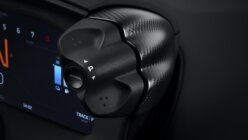McLaren has taken the covers off its newest supercar overnight, revealing the “Artura” in full for the first time. It’s a relatively familiar shape on the outside, but the Artura is packed with new technology, including a brand-new engine, and based on a totally new platform.
Underpinning Artura is McLaren’s new MCLA tub — McLaren Carbon Lightweight Architecture. Like previous McLaren road cars, this is a fully carbon-fiber item, but designed specifically for hybrid applications and, for the first time in a series production McLaren, built in the UK. Whereas previous McLarens have used variations of the MonoCell, built in Austria, the MCLA comes out of the brand’s new production facility near Sheffield.
The new chassis is part of a weight reduction strategy to offset the penalty of a battery pack and electric motor. In fact McLaren has gone to some unusual lengths to shed weight, including converting the entire vehicle electrical system to ethernet. By comparison to the usual CAN bus communication system, McLaren has been able to reducing cabling length by 25% and lose 10% from the system weight — as well as increasing network data rates, allowing the Artura to boast several new driver convenience systems.
Alongside the new chassis is a new engine. Previous models have all used a version of the Ricardo-built McLaren V8 which can trace its roots back to a Nissan endurance racing engine, but the Artura uses a new V6. The M630 engine is a three-liter V6 which, despite the unusual vee angle of 120 degrees, is both shorter and narrower than the V8 — as well as being 110lb (50kg) lighter.
This V6 uses a pair of single-scroll turbochargers mounted between the cylinder banks in a hot-vee arrangement, allowing for short and equal length exhausts feeding into the turbos for quicker spooling and a better throttle response. All in, the V6 produces some 577hp, giving the highest power density in a series production McLaren.
If that weren’t quite enough, the Artura also makes use of an electric motor — and even this is designed with light weight in mind. The motor is an axial flux design, something relatively new in automotive applications, which boasts a higher power density than traditional radial flux items. At 4.6kW/kg (2.7hp/lb), it’s a third more efficient than the motor in the McLaren P1, delivering 94hp despite weighing only 35lb. A five-module lithium ion battery provides 7.4kWh, and can both plug in for charging or recover charge while driving.
That all adds up to a total system output of 670hp, and 530lbft of torque, in a car that weighs just 100lb more than the McLaren 570S. The power units drive a new eight-speed version of the McLaren seamless-shift gearbox, which uses the electic motor torque to fill in the momentary gaps in the 200ms gear shifts. This new unit is also more compact than the old one, partly thanks to the loss of the reverse gear function; the electric motor simply operate backwards, for emissions free reversing.
Performance is just as you’d expect. 60mph will come up in three seconds flat, sprinting through the quarter mile in 10.7s, on its way to a 205mph top speed. Although yet to be fully homologated, fuel economy is around 42mpg (50.4mpg Imperial), with 129g/km emissions under WLTP testing protocols.
While the front suspension is similar to what you’d find in the McLaren 600LT, the rear suspension is all new, both enabled by and accounting for that new V6. The lower wishbones are split into two components, while the chassis pickup points are positioned further forward. As a result, the Artura saves around 11lb of unsprung mass, and has improvements in both ride and braking stability.
For the first time in a McLaren, the Artura will use an electronic rear differential. Again, this is lighter than the mechanical alternative, and helps with the torque distribution across the rear axle from the different power units. By addressing slip on each rear wheel individually, the e-diff improves corner exit traction and limits understeer.
The braking system uses carbon ceramic brakes as standard, with aluminum calipers derived from the 600LT. In addition the Artura retains the hydraulic power assisted steering for better feel and feedback compared to fully electric systems. There’s also a new version of the Proactive Damping Control system for improved ride and handling.
There’s several new features in the redesigned cabin too. A new “Clubsport” seat is available, which consists of a fixed carbon fiber shell for light weight, but which adjusts as a single item for driver and passenger comfort. McLaren says that a driver up to 6’4″ (193cm) should have no problem getting comfortable, although a 21lb (9.5kg) heavier comfort seat is also an option.
In addition, the Artura now features a steering column-mounted instrument cluster. This allows the driver to fix the steering wheel to the correct position for their requirements but maintain instrument visibility. There’s no controls of any kind on the steering wheel — which is somewhat rare these days — but all switches for control systems, such as handling modes, are close at hand.
The Artura uses a new version of the McLaren Infotainment and Connectivity System (MIS II), with two screens. It’s based around Android OS, allowing for phone-like operation and updates to add new features, and houses the audio system and navigation controls. The domain-based ethernet electrical architecture has also allowed McLaren to add features like intelligent adaptive cruise control, auto high beam, and lane departure warning, all of which you can control through MIS II’s portrait-mounted touchscreen.
You’ll be able to pick up the Artura in four grades, with a base specification alongside Performance, TechLux, and Vision trims, based around the interior design. McLaren has opened the order books already, with the base car coming in at $225,000 (£185,000), and first deliveries should take place in the third-quarter of this year.
See more articles on McLaren.

